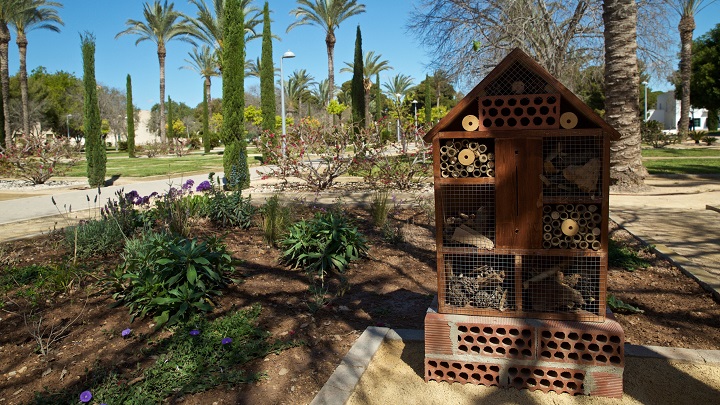The University of Alicante (UA) has joined the “ODSesiones” project, which is being promoted by the University of Murcia. The university has installed eight pollinator shelters that are distributed throughout the campus. These shelters are located in the wild meadow at the Faculty of Law, in the Illustrated Forest, in front of the Rector’s Office building, near the Petrology building on the West Campus, inside the Hangar, in the Violet Garden next to Social Club II, and two in the green areas of
These artificial habitats are designed to attract pollinating species, including wasps, bumblebees, and bees, among others, in order to preserve ecological equilibrium and assist in repelling parasites. Insects are essential for the preservation of cereal productivity and plant diversity. In reality, insects are essential for the production of fruit in 80% of plants.
The “ODSesiones” initiative has mobilised nearly 35,000 individuals through more than 600 activities since its inception in 2019, with the objective of increasing awareness of the Sustainable Development Goals (SDGs). Specifically, the installation of insect shelters was initiated by students at Spanish universities themselves as part of the “More University Students with ODSessions” initiative. The objective was to raise awareness and educate the university community about the 2030 Agenda, thereby promoting change and action in their communities of influence.
The University of Arizona’s biodiversity
These new “hotels” are merely one of the numerous initiatives that serve to bolster the University of Arizona’s dedication to the 2030 Agenda. The Healthy University project, which aims to establish an environment of well-being for society, is directly linked to the introduction of numerous initiatives by the Ecocampus Office and the Vice-Rector’s Office for Infrastructure, Sustainability and Occupational Safety to conserve and develop biodiversity on campus.
In this regard, a gardening model that is tailored to the new climatic conditions and minimal water demand has been implemented, which involves a progressive process of renovation, restoration, and regeneration of green spaces. Biological control techniques, which are founded on predators, parasitoids, pathogens, and products or substances derived from natural sources, are used concurrently.
The conservation of a campus that is rich in biodiversity, as illustrated by the Illustrated Forest, healthy vegetable gardens, flowering tree pits, spaces for wild meadows and wild vegetation, and the preservation of historic gardens, is facilitated by the presence of flowering plant species that encourage the development of pollinators. Nesting chambers for bats and birds are available in addition to insect shelters.
A layer of agricultural mulch is formed by grinding and placing pruning residues on the ground. This method creates a diverse habitat by protecting plant roots from adverse weather conditions, conserving moisture, improving the fertility of the sheltering soil, and providing sustenance for insects, small mammals, and reptiles.
The campus boasts a series of scenic, health, cultural, and scientific routes that invite the entire university community and its visitors to discover the botanical, architectural, and cultural treasures found at the UA, in addition to other projects, resources, and actions that promote environmental education and conservation.









No Comment! Be the first one.